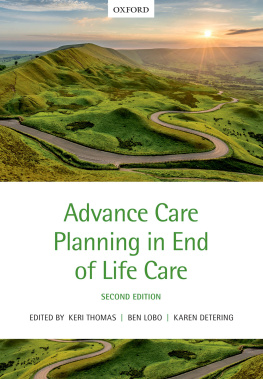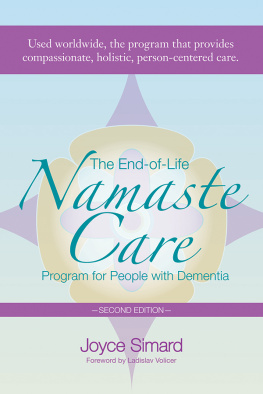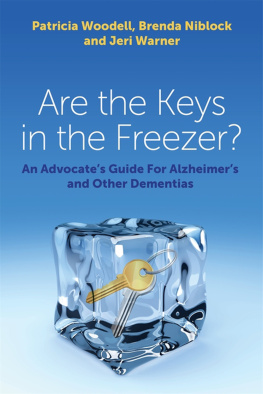The Better End
 THE BETTER END
THE BETTER END
Surviving (and Dying)
on Your Own Terms in
Todays Modern Medical World
DAN MORHAIM, M.D.

Note to the reader: This book is not intended to provide medical or legal advice. The services of a competent professional should be obtained whenever medical, legal, or other specific advice is needed.
2012 Dan Morhaim
All rights reserved. Published 2012
Printed in the United States of America on acid-free paper
9 8 7 6 5 4 3 2 1
The Johns Hopkins University Press
2715 North Charles Street
Baltimore, Maryland 21218-4363
www.press.jhu.edu
Library of Congress Cataloging-in-Publication Data
Morhaim, Dan.
The better end : surviving (and dying) on your own terms in todays modern medical world / Dan Morhaim.
p. cm.
Includes index.
ISBN-13: 978-1-4214-0417-2 (hardcover : alk. paper)
ISBN-13: 978-1-4214-0418-9 (pbk. : alk. paper)
ISBN-10: 1-4214-0417-6 (hardcover : alk. paper)
ISBN-10: 1-4214-0418-4 (pbk. : alk. paper)
1. Right to diePopular works. 2. Terminal carePopular works. 3. DeathPlanningPopular works. I. Title.
R726.M692 2012
179.7dc23 2011016536
A catalog record for this book is available from the British Library.
Special discounts are available for bulk purchases of this book. For more information, please contact Special Sales at 410-516-6936 or specialsales@press.jhu.edu.
The Johns Hopkins University Press uses environmentally friendly book materials, including recycled text paper that is composed of at least 30 percent post-consumer waste, whenever possible.
Contents
Acknowledgments
Taking care of a patient in an emergency room or shepherding a bill through the legislative processboth are cooperative endeavors, impossible to achieve by oneself. Ive learned that writing a book also requires many helping hands.
Foremost among them is Shelley Cole Morhaim, my lifes partner for 36 years, and in many ways the coauthor of this book. She labored with me over every idea, every draft, and every word. This book would not exist without her.
Im grateful to all the patients who entrusted me with their care. It is a privilege to be able to help people dealing with everything from the most minor conditions to life-threatening illness and injury. They have taught me so much.
The Better End began with a research project that evolved from my work at the Johns Hopkins Bloomberg School of Public Health and became a reality due to the hard work and talent of Dr. Keshia Pollack and the support of Dr. Clarence Lam, Dr. Michael Williams, Dr. Ellen Mackenzie, Dr. Michael Klag, Dr. Shannon Frattaroli, Michael Merson, and Bill Casey. In both her life and death, my colleague and sister-in-law, Mary Lou Cole, was a help and inspiration.
My colleagues in the Maryland General Assembly have helped to shape my understanding of how government can best empower citizens to take control of what is a deeply private right. My constituents in Marylands 11th District have honored me with their trust and guided me with their advice. Its impossible for any legislator to be an expert on all the issues that come before him or her. The public doesnt always realize how much we depend on their input.
Im grateful to my medical colleagues, and especially to Dr. Michael Auerbach, an unfailing source of wisdom and support.
At key moments in the writing of this book, Ive had help from my daughters, Emily, Sarah, and Elizabeth, and from my friends Jan Houbolt, Mike Reed, Jim Kunz, David Heath, Andy Gruver, David Kandel, Brent Flickinger, Geoff Basik, Bob Brown, George Kosmides, Margie von Rueden, Ben Pomerantz, Bonnie Pastor, and Susan Sarno.
Im also grateful to Bob Silverstein of Quicksilver Books and to Jackie Wehmueller of the Johns Hopkins University Press for believing in the work of a first-time author. Jackie offered cogent advice and critiques all along the way. Its been a pleasure and an education to work with an editor who knows her craft so well.
The Better End
Introduction
Then and Now
Lets go back in time 100 years.
At age 50, Harold Johnson, a farmer in western Pennsylvania, had already exceeded the average life expectancy for his era. Two of his siblings and one of his own children had passed away before reaching the age of 20. A daughter-in-law had died in childbirth. Despite these losses, Harold had enjoyed a full life with Martha, his wife of 26 years, with whom he had four living children and two grandchildren.
But now Harolds life was nearing its close. He developed a bad cold that lingered over the winter. It seemed to intensify the pains he occasionally felt in his chest after physical labor, and hed had to ask his sons to manage the spring planting without his help. As summer wore on, even the least exertion left him out of breath, until finally he lacked the strength to get out of bed most days.
Dr. Reed, the Johnson familys physician, had trained at Yale Medical College in Connecticut and kept up with all the latest advances. Hed managed to buy Harold a few years of pain relief using nitroglycerin tablets, but as Harolds heart muscle deteriorated, his blood flow decreased. His skin became pale, and fluid began to build up in his lungs, making his breathing even harder. Then pneumonia set in.
When Dr. Reed was called, he confirmed what Harold and Martha suspected: the end was drawing near for Harold. Dr. Reeds scientific medical bag was fairly empty. The antibiotics that could have cured Harolds pneumonia wouldnt be available for another three decades. The cardiac surgery, appliances, and medications that could have repaired his hearts function were even more distantly removed70 to 90 years in the future. But Dr. Reed wasnt entirely helpless. Hed known the Johnson family for years, and just his presence provided a degree of comfort and dignity to Harolds dying process. Dr. Reed made daily house calls, feeling Harolds pulse, charting the course of his fever and other symptoms, and counseling Harold and Martha. He let them know when it was time to summon the children and grandchildren, the minister from their church, and Harolds brother from Baltimore.
Pneumonia used to be known as the old persons friend, because it brought a gradual but relatively quick and painless end. As Harold failed, his family and friends came to say goodbye. They talked with Harold about his life and times, both the good and the bad.
As the days progressed, Harolds breathing became more labored, then shallower. He drifted in and out of consciousness. Finally, he lapsed into a coma. With Martha at his side, and his children and grandchildren surrounding his bed, Harold breathed his last.
Now, fast-forward 100 years.
At 83, Harolds great-grandson Bill had already outlived his ancestor by 30-plus years. His three children and five grandchildren all survived into adulthood, and he was able to welcome his first great-grandchild. Bill and his wife, Alice, lived an active life in their community until Bill was diagnosed with prostate cancer at age 75. Surgery and chemotherapy kept the cancer in remission for a number of years, but eventually it returned; this time it did not respond to treatment. As the cancer spread through his body, Bill followed the advice of his oncologist, radiologist, surgeon, and internist. All of them were highly trained specialists and were well versed in the course of Bills disease, but none knew Bill or Alice very well as individuals.
Next page





 THE BETTER END
THE BETTER END
